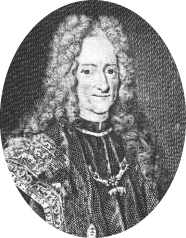Gundaker Thomas Starhemberg
Count Gundaker Thomas Starhemberg (born December 14, 1663 in Vienna , † July 8, 1745 in Prague ) was a financial expert in the service of the Habsburg Emperor ; from 1698–1700 Vice President, 1703–15 President of the Court Chamber, 1706–45 President of the Ministerial Office Deputation, from 1712 member of the Secret Conference, from 1716 of the Secret Finance Conference.
Life
Gundaker Thomas Graf Starhemberg was the (half) brother of Count Ernst Rüdiger , the famous defender of Vienna, third son of Count Konrad Balthasar von Starhemberg and his second wife, Franziska Katharina, née. Countess Cavriani . Intended for the clergy in 1677, in 1682 he received the dignity of canon of Olomouc . Two years later, at his father's request, he was to enter the Collegium Germanicum in Rome, it turned out that he did not feel called to the clergy.
He moved to Vienna and became a kk chamberlain , then he was court chamber councilor and then vice-chamber president. In 1703, Emperor Leopold I removed Counts Mansfeld and Salburg from their offices and transferred the presidium of the Court War Council to Prince Eugene and the management of the Court Chamber for Finances to Count Gundakar. As a secret and conference council, he acted under the following emperors Joseph I and Charles VI. from 1704 to 1717 as deputation president of the imperial court chamber. His achievements were recognized by being awarded the Order of the Golden Fleece . After the last Prince of Eggenberg died, he received with a diploma from May 16, 1717 and his heirs from the Kaiser the dignity of Hereditary Marshal of Austria above and below the Enns. He expanded his possessions by skillfully financing and purchasing the lordships of Rottenegg (1712), Reichenstein and Greisingberg (1730), the Goldwörth office and the ability to hunt in the Passau monastery (1731). His other possessions included:
- Steinberg Palace
- Palais Starhemberg on Dorotheergasse
- Schönburg Palace
- Graz Castle
- Pottendorfer parish church
- Pottendorf Castle
- Schloss Haus (Wartberg ob der Aist)
Count Gundakar was first married (1680) to Beatrix Franziska Countess Daun. After her early death in 1701, he married Maria Josepha (born von Jörger), the widow of his half-brother Ernst Rüdiger, for the second time on February 3, 1707. Graf had two sons and four daughters from his first marriage, and five more daughters from his second marriage. Of the sons, the younger, Ferdinand Ottokar, was chosen for the clergy, while the older Franz Anton continued the secular inheritance.
literature
- Constantin von Wurzbach : Starhemberg, Gundakar Thomas Graf . In: Biographisches Lexikon des Kaiserthums Oesterreich . 37th part. Imperial-Royal Court and State Printing Office, Vienna 1878, p. 179 f. ( Digitized version ).
- Hanns Schlitter: Starhemberg, Gundaker Thomas Graf von . In: Allgemeine Deutsche Biographie (ADB). Volume 35, Duncker & Humblot, Leipzig 1893, pp. 480-482.
- Brigitte Holl: Court Chamber President Gundaker Thomas Graf Starhemberg and the Austrian financial policy of the baroque period. (1703-1715). Publishing house of the Austrian Academy of Sciences, Vienna 1976, ISBN 3-7001-0130-9 ( Archive for Austrian History 132).
Web links
- Entry on Gundaker Thomas Starhemberg in the Austria Forum (in the AEIOU Austria Lexicon )
| personal data | |
|---|---|
| SURNAME | Starhemberg, Gundaker Thomas |
| BRIEF DESCRIPTION | Austrian financial expert and President of the Ministerial Bank Deputation |
| DATE OF BIRTH | December 14, 1663 |
| PLACE OF BIRTH | Vienna |
| DATE OF DEATH | July 8, 1745 |
| Place of death | Prague |
